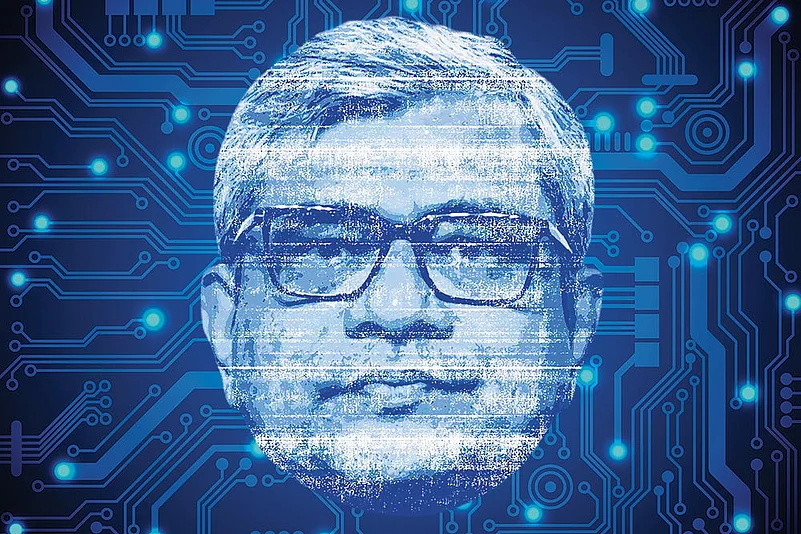India’s efforts to enter the global semiconductor chip manufacturing domain got a shot in the arm this year when US-based chipmaking giant Micron Technology began the construction of its $2.75 billion semiconductor plant in Sanand in Gujarat. While Prime Minister Narendra Modi’s followers hail him for his enthusiasm in trying to make India a global semiconductor manufacturing hub, the role of his trusted lieutenant, Union minister of electronics and information technology Ashwini Vaishnaw, has not gone unnoticed.
Vaishnaw is unlike most other Union ministers before him. When he took charge at the Ministry of Electronics and Information Technology (MeitY) in July 2021, he had been a parliamentarian for barely two years. Neither did he have any ministerial experience, nor did he have much sway within the Bharatiya Janata Party (BJP). After all, he joined it only after receiving the Rajya Sabha nomination from Odisha in 2019. He was elected unopposed to the upper house, thanks to the support from the Biju Janata Dal.
Vaishnaw brought to the table at MeitY his decade-plus experience as a bureaucrat, coupled with his Ivy League pedigree and familiarity with global corporate structures. He completed M.Tech from IIT, Kanpur, and joined the Indian Administrative Service in 1994 as an Odisha cadre officer.
By 2003, he was walking in the highest corridors of power when he joined the office of then prime minister Atal Bihari Vajpayee as a deputy secretary. Later, he took a hefty loan to pursue MBA at the Wharton Business School in the US. On his return to India, he exited civil service and took up top managerial roles in multinational corporations like General Electric and Siemens one after the other. Before eventually making his foray into politics, the Jodhpur-born engineer even had entrepreneurial stints in Gujarat.
The Semiconductor Vision
In the past, the country had tried many times to set up a semiconductor policy that would attract leading chipmaking companies to set up shop in India. However, all the previous policies failed, which meant that India fell behind in a domain where the likes of China, Taiwan and the US took lead. After the BJP government retained power at the Centre in 2019, it announced the Semicon India programme under MeitY with an incentive outlay of $10 billion in December 2021. This was less than six months after a cabinet shuffle saw Vaishnaw taking charge of the ministry.
When Vaishnaw was inducted into the cabinet, many were surprised by the bureaucrat-turned-politician’s quick rise. The fact that he was given three major portfolios—electronics and IT, communications and railways—made them curious. But some believe that MeitY has become “more enterprising” under Vaishnaw’s leadership, given that he is not a career politician.
“With minister Vaishnaw, there is a good understanding of what the big, global companies are expecting from India’s semiconductor incentives. The companies do not want to get stuck in bureaucratic loops, and ... [Vaishnaw] knows how to communicate in that language,” says an executive working closely with the India Semiconductor Mission.
At the annual meeting of the World Economic Forum in Davos this January, Vaishnaw said that India had plans to become a key semiconductor supplier for the world. Back then, the country’s chipmaking programme did not have any successful proposals to boast of, and its $10 billion kitty was lying idle. What many did not know then was that Micron’s proposal to establish a semiconductor assembly, testing and marking facility was already under serious consideration in Vaishnaw’s office.
The Strategist
In May, Vaishnaw visited the US along with several officials from MeitY. One of the main agendas of the visit was to meet senior executives from leading chip companies like Intel and AMD and to invite them to India. Vaishnaw also met the top brass at Micron during his three-day visit, reportedly to iron out details before the company’s proposal could be approved.
The Cabinet cleared the proposal the following month, right before Prime Minister Modi’s state visit to the US. That was when the formal announcement of Micron’s Sanand plant was made. A week later, AMD announced that it would invest $400 million over the next five years to set up a design centre in Bengaluru.
“Vaishnaw’s strategic engagement with leading chip players in Silicon Valley, including Intel, Google and SEMI, aimed to attract investments to bolster India’s semiconductor capabilities. These achievements underscore India’s commitment to becoming a global hub for semiconductor manufacturing and design, with MeitY playing a pivotal role by creating a conducive policy environment, facilitating infrastructure development and engaging industry stakeholders,” says Sanjay Gupta, chairman of the India Electronics and Semiconductor Association.
Last month, Vaishnaw announced that 27 companies, including HP, Dell and Foxconn, will soon be manufacturing IT hardware—computers, tablets and servers—in the country under a production-linked incentive (PLI) scheme. This is expected to bring in investments worth Rs 3,000 crore and create close to two lakh jobs.
MeitY already views its PLI scheme for mobile manufacturing as a success that resulted in domestically assembled smartphones accounting for 98% of overall shipments in 2022, as opposed to 19% in 2014. The establishment of a powerful electronic hardware ecosystem is part of a grander scheme of becoming a hub of hi-tech manufacturing.
Vaishnaw can pat himself on the back for the fact that India’s semiconductor dreams, which lay dormant for decades, finally took wings under his stewardship. As a minister who comes from a non-conventional background, he had to prove many naysayers wrong. With many more proposals in the pipeline, including for chip fabrication facilities, Vaishnaw can rest assured knowing that his tenure at the helm of MeitY will be remembered for taking India several steps ahead in its semiconductor dreams.


























